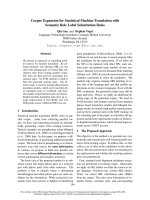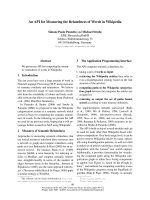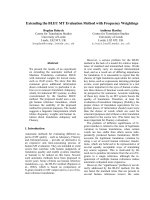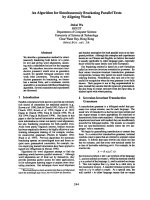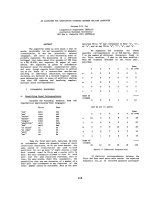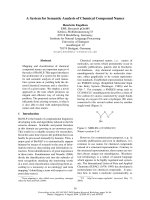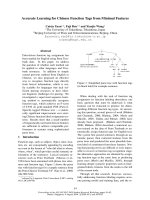Báo cáo khoa học: "An Algorithm For Generating Referential Descriptions With Flexible Interfaces" pdf
Bạn đang xem bản rút gọn của tài liệu. Xem và tải ngay bản đầy đủ của tài liệu tại đây (709 KB, 8 trang )
An Algorithm For Generating Referential Descriptions
With Flexible Interfaces
Helmut Horacek
Universit/it des Saarlandes
FB 14 Informatik
D-66041 Saarbrticken, Deutschland
Abstract
Most algorithms dedicated to the generation of
referential descriptions widely suffer from a
fundamental problem: they make too strong
assumptions about adjacent processing
components, resulting in a limited coordination
with their perceptive and linguistics data, that
is, the provider for object descriptors and the
lexical expression by which the chosen
descriptors is ultimately realized. Motivated by
this deficit, we present a new algorithm that (1)
allows for a widely unconstrained, incremental,
and goal-driven selection of descriptors, (2)
integrates linguistic constraints to ensure the
expressibility of the chosen descriptors, and (3)
provides means to control the appearance of the
created referring expression. Hence, the main
achievement of our approach lies in providing a
core algorithm that makes few assumptions
about other processing components and
improves the flow of control between modules.
1 Introduction
Generating referential descriptions I requires selecting a set
of descriptors according to criteria which reflect humans
preferences and verbalizing these descriptors while
meeting natural language constraints. Over the last decade,
(Dale, 1989, Dale, Haddock, 1991, Reiter, 1990b, Dale,
Reiter, 1995), and others 2 have contributed to this issue
The term 'referential description' is due to Donellan
(Donellan, 1966). This notion signifies a referring
expression that serves the purpose of letting the hearer
identify a particular object out of a set of objects
assumed to be in the current focus of attention.
The approach undertaken by Appelt and Kronfeld
(Appelt, 1985a, Appelt, 1985b, Kronfeld, 1986,
Appelt, Kronfeld, 1987) is very elaborate but it suffers
from very limited coverage, missing assessments of
the relative benefit of alternatives, and notorious inef-
ficiency.
(see the systems NAOS (Novak, 1988), EPICURE (Dale,
1988), FN (Reiter, 1990a), and IDAS (Reiter, Dale,
1992)). Nevertheless, these approaches still suffer from
some crucial deficits, including limited coverage (see
(Horacek, 1995, Horacek, 1996) for an improved algo-
rithm), and too strong assumptions about adjacent
processing components, namely:
• the instant availability of all descriptors for an object
to be described,
• the adequate expressibility of a chosen set of
descriptors in terms of lexical items.
Motivated by the resulting deficits, we develop a new
algorithm that does not rely on these assumptions. It (1)
allows for a widely unconstrained, incremental, and goal-
driven selection of descriptors, (2) integrates linguistic
constraints to ensure the expressibility of the chosen
descriptors, and (3) provides means to control the appear-
ance of the created referring expression.
This paper is organized as follows. After having
introduced some basic terminology, we elaborate interface
deficits of existing algorithms, form which we derive desi-
derata for an improved algorithm. Then we describe
concepts to meet these desiderata, and we illustrate their
operationalization in a schematic and in a detailed version.
Finally, we demonstrate the increased functionality of the
new algorithm, and we evaluate the achievements.
2 Terminology Used
In the scope of this paper, we adopt the terminology
originally formulated in (Dale, 1988) and also used by
several successor approaches. The referring expression to
generate is required to be a
distinguishing description,
that
is a description of the entity being referred to, but not to
any other object in the current
context set. A context set
is defined as the set of entities the addressee is currently
assumed to be attending to - this is similar to the set of
entities in the focus spaces of the discourse focus stack in
Grosz and Sidner's theory of discourse structure (Grosz,
Sidner, 1986). Moreover, the
contrast set
(or, the set of
potential distractors
(McDonald, 1981)), is defined to
entail all elements of the
context set
except the
intended
206
referent.
In the scope of some
context set,
an attribute or a
relation applicable to the
intended referent
can be assigned
its
discriminatory power, 3
that is a measure similar to the
number of
potential distractors
that can be removed from
the
contrast set
with confidence, because this attribute or
relation does not apply to them.
3 Previous Algorithms and Deficits
The existing algorithms attempt to identify the intended
referent by determining a set of descriptors attributed to
that referent or to another entity related to it, thereby
keeping the set of descriptors as small as possible. This
minimization issue can be interpreted in different degrees
of specificity, which also has consequences on the asso-
ciated computational complexity.
Full brevity,
the
strongest interpretation, is underlying Dale's algorithm
(Dale, 1989), which produces a description entailing the
minimal number of attributes possible, at the price of
suffering NP-hard complexity. Two other interpretations,
the
Greedy heuristic interpretation
(Dale, 1989) and the
local brevity interpretation
(Reiter, 1990a) lead to algo-
rithms that have polynomial complexity in the same order
of magnitude. The weakest interpretation,
the incremental
algorithm interpretation
(Reiter, Dale, 1992), has still
polynomial complexity but, unlike the last two interpre-
tations, it is independent of the number of attributes avail-
able for building a description. Applying this interpre-
tation may lead to the inclusion of globally redundant
attributes in the final description, but this is justified by
various results of psychological experiments (see the
summary in (Levelt 1989)). Because of these reasons, the
incremental algorithm interpretation is generally consi-
dered best now, and we adopt it for our algorithm, too.
In the realization described in (Reiter, Dale, 1992),
attributes are incrementally selected according to an a
priori computed domain-dependent preference list, provided
each attribute contributes to the exclusion of at least one
potential distractor. However, there still remains the
problem of meaningfully applying this criterion in the
context of nested descriptions, when the intended referent
is to be described not only by attributes such as color and
shape, but also in terms of other referents related to it.
Neither the psychological experiments nor the realization
in (Reiter, Dale, 1992) can deal with this sort of recur-
sion. In the generalization introduced in (Horacek, 1996),
descriptors of the referents are incrementally selected
according to domain-dependent preference lists in a limited
depth-first fashion, which leads to some sort of inflexibi-
lity through restricting the set of locally applicable
3 A precise definition based on numerical values assigned
to attribute-value pairs is given in (Dale, 1988).
descriptors. Besides, the preference list needs to be fully
instantiated for each referent to be described, which consti-
tutes a significant overhead.
An even more crucial problem lies in the fact that
practically all algorithms proposed so far contend them-
selves with producing a set of descriptors rather than
natural language expressions. They more or less impli-
citly assume that the set of descriptors represented as one-
and two-place predicates can be expressed adequately in
natural language terms. A few drastic examples should be
sufficient to illustrate some of the problems that might
occur due to ignoring these issues:
(a) the bottle which is on a table on which there is a
cup which is besides the bottle
(a problem of organization)
(b) the large, red, speedy, comfortable car
(a problem of complexity)
(c) the cup which is besides a bottle which is on a table
which is left to another table and which is empty
(a scoping problem, in addition)
Altogether, two strong assumptions influence existing
algorithms, namely the instant availability of all descrip-
tors of a referent and the satisfactory expressibility of the
chosen set of descriptors. They are responsible for three
serious deficits negatively influencing the quality of the
expression (the first one primarily causing inefficiency):
1. Applicable processing strategies are restricted because
all descriptors of some referent need to be evaluated
before descriptors of other referents can be considered.
2. The linguistic aspects are largely simplified and even
neglected in parts. Because of the 'generation gap'
(Meteer, 1992), there is no guarantee that the set of
descriptors chosen can be expressed at all in the target
language, not to say adequately.
3. There is no control to assess the adequacy of a certain
description, for instance, in terms of structural com-
plexity, and no feedback from linguistic form
production to property selection is provided.
The first deficit restricts feasible architectures of a gener-
ation system in which such an algorithm can reasonably
be embedded because flexibility and incrementality of the
descriptor selection task are limited. Moreover, the under-
lying assumption is unrealistic in cognitive as well as in
technical terms. From the perspective of human behavior,
it would simply be unnecessary to determine all descrip-
tors of a referent to be described beforehand without even
attempting to generate a description; usually, just a few
descriptors are sufficient for this purpose. The same consi-
derations apply to the machine-oriented perspective:
neither for a vision system nor for a knowledge-based
system is it without costs to determine all descriptors of a
certain object - especially for the vision system, the
computational effort may be considerable.
207
The second deficit results from ignoring that the ulti-
mate goal envisioned consists in producing a natural
language expression that satisfies the discourse goal and
not merely in choosing a set of descriptors by which this
goal can in principle be achieved. In general, there is no
guarantee that the set of descriptors chosen can be ade-
quately expressed in the target language, given some
repertoire of lexical operators: conceptual predicates
cannot always be mapped straightforwardly onto lexemes
and grammatical features so that the anticipation of their
composability is limited. Even more importantly, matters
of grammaticality are not taken into account at all by
previous algorithms. Simple cases are not problematic,
for instance, when two descriptors achieve unique identifi-
cation and can be expressed by a simple noun phrase
consisting of a head noun and an adjective. In more
complex cases, however, considerations of grammaticality
such as overloading and even interference due to scoping
ambiguity may become a serious concern.
The third deficit concerns the lack of control that these
algorithms suffer from when assessing the structural
complexity of a certain description is required, which
certainly influences its communicative adequacy, too. The
lack of control over the appearance of the expression to be
generated is further augmented by the fact that any kind of
feed-back is missing that puts the property selection
facility in a position to take the needs of ultimately
building a referring expression into account. Particular
difficulties can be expected when a referential description
needs to be produced in an incremental style, that is,
portions of a surface expression are built and uttered once
a further descriptor is selected, that is, prior to completion
of the entire descriptor selection task.
4 Conception of a New Algorithm
Besides the primary goal of producing a distinguishing
and cognitively adequate description of the intended refer-
ent, there are also the inherent secondary goals of verbally
expressing the chosen descriptors in a natural way, and of
applying a suitable processing strategy. In order to pursue
these goals, we state the following desiderata:
1. The requirements on the descriptor providing
component should widely be unconstrained, allowing
for incremental and goal-driven processing.
2. A component that takes care of the expressibility of
conceptual descriptors in terms of natural language
expressions should be interfaced.
3. Adequate control should be provided over the comple-
xity and components of the referring expression.
Several concepts are intended to meet these desiderata:
I. In the predecessor algorithms, attributes are taken
from an a priori computed domain-dependent prefer-
ence list in the indicated order, provided each attribute
contributes to the exclusion of at least one potential
distractor. Instead, we simply allow the responsible
component to produce descriptors incrementally, even
from varying referents, provided the selected descriptor
is directly related to some referent already included in
the expression built so far. While the precise form of
this restriction is technically motivated - it guaran-
tees that a description built this way is always
connected - we believe that it is also cognitively
plausible. In order to pursue the identification goal,
the perception facilities preferably look for salient
places in the vicinity of the object to be identified,
rather than to distant places. The pre-selection obtain-
ed this way can be based on salience, eventually
combined with some measure of computational effort.
By applying this strategy, a best-first behavior is
achieved instead of pure breadth-first (Reiter, Dale,
1992), depth-first (Dale, Haddock, 1991), and iterative
deepening (Horacek, 1995, Horacek, 1996) strategies.
2. The algorithm interfaces a subprocess that incremen-
tally attempts to build natural language expressions
out of the descriptors selected. Through taking gram-
matical and lexical constraints into account, this pro-
cess is capable of exposing expressibility problems
early: expressing a proposed descriptor may require
refilling an already filled slot, or integrating the map-
ping result of a newly inserted descriptor may lead to
a global conflict such as unintended scope relations.
A goal-driven aspect is added by encouraging the
selection of descriptors whose images are candidates
of filling empty slots in the expression built so far.
3. The algorithm enables one to control the processing
aspect of building the referential description and its
complexity. A parameter is provided to specify the
appearance of that expression in terms of slots that
are allowed to be filled. In an incremental style, where
parts of the referential description are uttered prior to
its completion, the slots that can be filled by the des-
criptor selected are substantially influenced by prece-
dence relations (in the ordinary compositional style,
this is simply identical to the set of yet empty slots).
5 Operationalization in the Algorithm
The new algorithm designed to incorporate these concepts
is built on the basis of some predecessor algorithms
(Dale, Haddock, 1991, Reiter, Dale 1992, Horacek, 1995,
Horacek, 1996), from which we also adopt the notation.
The algorithm is shown in two different degrees of preci-
sion. An informal, schematic view in Figure 1 that
abstracts from technical details is complemented by a
detailed pseudo-code version in Figure 2. In both versions,
the lines are marked, by IS#] in the schematic view and
by [C#] in the pseudo-code version to ease references from
208
Check Success
if <the intended referent is identified uniquely>
then <exit with an identifying description>
if <the complexity limit of the expression is reached>
then <exit with a non-identifying description>
Choose property
if <no further descriptors are available>
then <exit with a non-identifying description>
else <call the descriptor selection component to propose the next property>
if <the descriptor does not reduce the set of potential distactors> or
<the referent further described is already identified uniquely> or
<the descriptor is inferable from the description generated so far> or
<the descriptor cannot be lexicalized with the given linguistic resources> or
<lexicalizing the descriptor would cause a scoping problem>
then <reject the proposed property> and goto 2
Extend description
<update the linguistic resources used>
<determine properties which, when being lexicalized, are likely to fill yet empty slots>
<update the constraints holding between referents and partial descriptions>
goto 1
[SI]
[$2]
[s3]
[s4]
[ss]
[$61
[$7]
[s81
[s9]
is10]
[Sl~l
[sl2]
[S13]
IS ~4]
[sis]
[S16]
[S17]
[S18]
[S19]
[$20]
Figure 1 : Schematic presentation of the algorithm, as
the text. In addition, the identifiers used in the pseudo-
code version are explained in Table 1 (the variables) and in
Table 2 (the functions).
We first illustrate the basic structure of the procedure
from some sort of a bird's eyes view. The algorithm
consists of three major parts:
Check success
IS 1 ],
Choose
property
[$6], and
Extend description
[S16]; this organi-
zation stems from (Dale, Haddock, 1991) and is extended
here. Basically, these parts are evaluated in sequence,
which is repeated iteratively [$20]. The first part merely
comprises two of the algorithm's termination criteria:
[$2], which constitutes the successful accomplishment of
the whole task, and [$4], which reports the failure to do
this within the given limits of the linguistic resources,
and corresponding return statements [$3] and [$5]. [$4]
and [$5] constitute an extension to previous approaches.
The second part entails a call to an external descriptor
selection component [$9]. In the unlikely case that no
further descriptors are available [$7] the algorithm termi-
nates without complete success [$8]. Various tests check
the suitability of the descriptor proposed in the global
context: the descriptor does not contribute further to the
identification task (it must be an attribute) [S 10], the need
of further elaborating the description of that referent to
which the proposed descriptor adds information [SI 1 ], the
descriptor's effective contribution to the identification
task, which may be nullified due to contextual effects
[S12], unavailability of lexical material to express the
an abstraction from the detailed pseudo-code in Figure 2
proposed descriptor as an extension to the referring expres-
sion composed s.o far [S13], and scoping problems in the
attempt in extending the referring expression composed so
far [S 14]. The last two criteria are additions introduced in
the new algorithm. In the third part, some sort of book
keeping is carried out: evidence about the used lexical
resources is updated IS 17], descriptors that are likely to be
expressible by yet empty slots are determined IS 18], and
relations between the context sets of all referents consid-
ered and partial descriptions are maintained [S19].
After this overview, we explain the algorithm in detail.
We describe the data structure that helps controlling to
whether or not a referent is identified and which the poten-
tial distractors are. Next, we illustrate the interfaces to the
two major external modules. We conclude this presen-
tation by explaining the pseudo code, thereby pointing to
the corresponding parts in the schematic overview. In
companion with the variables and functions explained in
separated tables, this description should enable the reader
to understand the functionality of the algorithm.
Throughout processing, the algorithm maintains a
constraint network N which is a pair relating (a) a set of
constraints, which correspond to predications over vari-
ables (properties abstracted from the individuals they
apply to) to (b) sets of variables each of which fulfill
these constraints in view of a given knowledge base (the
context sets). The notation N ~ p is used to signify the
result of adding the constraint p to the network N. In
209
Variable
Description
r, gr,v, gv
R
C
N
C
L
FD
DD
List
<p,r>
refs
P-props
excluded
local (r) and global referents (gr) and variables (v and gv) associated with them
a specification of slots which the target referring expression may entail
(contextually-motivated) expected category of the intended referent
constraint network, a pair relating a set of constraints to sets of variables fulfilled by them
context set, indexed by variables associated with referents (e.g., C v, Cg v)
list of attribute-value pairs which corresponds to the constraint part of N
functional description that is an appropriate lexical description expressing L
distinguishing description, appearing as a pair <L,FD>
communicative goals to pursue, expressed by Describe(r,v)
property p ascribed to referent r
referents already processed
properties whose images on the lexical level are likely to fill empty slots in FD
property-referent combinations that cannot be verbalized in the given context
Table 1: Variables used in the algorithm
addition, the notation [r~v]p is used to signify the result of
replacing every occurrence of the constant r in p by
variable v (for an algorithm to maintain consistency see
AC-3 (Mackworth, 1977), as used in (Haddock, 1991)).
According to our desiderata, the new algorithm inter-
faces two major external modules whose precise function-
ality is outside the scope of this paper: Next-Property and
Insert-Unify. Next-Property [C19], [$9] selects a cogni-
tively-motivated candidate property to be included next.
Generally applicable psychological preferences, such as
basic level categories, as well as special criteria, such as
degrees of applicability of local relations [Gapp 1995],
may guide this selection. It is additionally influenced by
two parameters: refs, which specifies those referent which
must be directly related to the chosen descriptor, and P-
props, which entails a list of properties whose lexical
images are likely to fill yet empty slots.
Insert-Unify updates the data structure FD by incre-
mentally inserting mappings of selected descriptors [C43],
[S13], unless Check-Scope detects a global problem
[C44], [S 14]. This language-dependent procedure analyzes
the functional description created so far for potential mis-
interpretations and scope ambiguities, which may occur in
connection with nested postnominal modifiers or relative
clauses that depend on an NP with a postnominal modi-
fier. Examining these structures is much less expensive
than a global anticipation-feedback loop, but it requires
specialized grammatical knowledge. Whether the intended
reading is also the preferred one depends on selectional re-
strictions, preference criteria, and morphological features.
Function Description
Next-Property(refs, ps)
A(p)
find-best-value(A(p),V)
basic-level-value(r,A(p))
rules-out(<A(p),V>)
Assoc-var(r)
Prototypical(p, r)
Descriptors(r)
Map-to(Empty-Slots(FD))
lnsert-Unify( FD,<v,p> )
Check-Scope(FD)
Slots-of(mappings(p))
Rel(A(p) )
Salient(A(p))
selects a property, influenced by the connection to referents refs and by properties ps
functor to provide access to the predicate of predication p
procedure to determine the value of property p that describes r according to (Dale, Reiter, 1992)
yields the basic level value of property p for referent r
yields the set of referents that are ruled out as distractors due to the value V of property A(p)
function to get access to the variable associated with referent r
yields true if property p is prototypical for referent r and false otherwise
yields the set of predicates entailed in N and holding for referent r
yields properties which map onto the set of uninstantiated slots in FD
inserts a lexical description of property p of the referent associated with variable v into FD
yields true if no scope problems are expected to occur and false otherwise
yields the slots of the set of lexical items by which predicate p can be expressed
yields true if descriptor p is a relation and false otherwise
yields true if salience is assigned to property p and false otherwise
Table 2: Functions used in the algorithm
210
D_.e ~.(lh~ ( r, v, N, R, c )
DD ~
nil,
FD ~
nil
[CI]
unique ~
false
[C2]
gr ~ r, gv 6 v [C3]
excluded ~
nil,
P-props ~
nil
[C4]
rel:~ ~ {r} [C5l
Cv~ Cvn {x I c(x)} [C6]
List + [Describe(r,v)] [C7]
1
Check Success
[C8]
if
ICxvl = 1 then [C9]
• unique +
true
[CI0]
return
<L,FD>
(as
a distinguishing description) [CI I]
endif
[C 12]
if
IRI = 0
then
[C13]
return
<L,FD> [C 14]
(as a non-distinguishing description) [C 15]
endif
[C 16]
2
Choose Property
[C17]
repeat
[C18]
<r,p> ~ Next-Property(rely,P-props) [C19]
if
p =
nil then
[C20]
return
<L,FD> [C21]
(as a
non-distinguishing description) lC22]
endif
[C23]
v ~ Assoc-var(r) [C24]
if Prototypical(p,r) or
[C25]
((Slots-of(Mappings(p))
n R) = O) [C26]
then
excluded ~ excluded u { <r,p> I [C27]
elseif (p in Taxonomic-Inferences
[C28]
(Descriptors(v))) or
(ICvl 1) then [C29]
excluded ~- excluded u { <r,p> } [C30]
endif [C31 ]
endif
[C32]
if
<r,p> e excluded
then
lC33]
goto
2 [C34]
endif
[C35]
V = find-best-value(A(p), [C36]
basic-level-value(r,A(p)))
[C37]
if not (((rules-out(<A(p), V>) ~ nil) and (V ~ nil)) [C38]
or Rel(A(p))) or Salient(A(p)) then
[C39]
excluded ~ excluded u {<r,p> } [C40]
goto 2 [C41 ]
endif
[C42]
FDH ~ Insert-Unify(FD, <v,p>) [C43]
if not
Check-Scope(FDH)
then
[C44]
excluded ~ excluded u {<r,p>} [C45]
goto 2 [C46]
endif
[C47]
3
Extend Description
[C48]
FD ~ FDH [C49]
R ~ R \ slots(FD) [C50]
P-props ~ Map-to(Empty-slots(FD)) [C51]
p ~ [r\vlp [C52]
if Rel(A(p)) then
[C53]
for every other constant
r'
in p do
[C54]
if
Assoc-var(r') =
nil then
[C55]
associate
r'
with a new, unique variable
v' [C56]
p ~ [r'~vqp [C57]
ref~ ~ rel;~ u {r7 [C58]
List ~ Append(List, Describe(r'v')) [C59]
endif
[C60]
next
[C61 ]
else set the value of attribute p to
V [C62]
endif
[C63]
N ~- N
@
p [C64]
goto
1 [C65]
Figure 2: Detailed pseudo-code of the new algorithm
The first part of the algorithm, 'Check Success',
comprises the algorithm's termination criteria:
1. A distinguishing description is completed [C9-C11],
[$2-$4], the exit in case of full success.
2. No more descriptors are globally available [C19-
C22], [$7-$8]. In the predecessor algorithms, this
check is done for each referent separately.
3. All available slots are filled [C13-C14], [$4-$5] -
this is a new criterion.
The second part, 'Choose Property', is dedicated to test the
contextual suitability of the candidate property proposed
by
Next-Property,
which may be inappropriate for one of
the following reasons (criteria 3. and 5. are new ones):
1. The property can be inferred from the description
generated so far, or it is prototypical for the object to
be identified and may thus yield a false implicature
[C25, C28], [S12].
2. The object is already identified uniquely [C29], [SI 1].
3. The descriptor chosen cannot be mapped onto a slot
of the description generated so far [C26], [S 13].
4. The descriptor is an attribute, and it does not further
reduce the set of potential distractors [C38], [S 10].
5. Incorporating the descriptor into the functional
description created so far leads to a global conflict
[C43-C44], [S14].
The third part, 'Extend Description', takes care of updating
some control variables. The descriptor p is fed into N
[C64] goals to describe new referents reached via the
relation p are put into
List
[C54-C60], [S19], all slots
filled in
FD
are eliminated in R [C50], [S17], and the yet
empty slots are fed into reversed lexicalization rules to
yield properties collected in
P-props
[C51 ], [S 18].
6 Effects the Algorithm Can Handle
Space restrictions do not permit a detailed presentation of
the new algorithm at work. Therefore, we have confined
ourselves to a sketchy description of the algorithm's
behavior in a moderately complex situation. Let us
assume an environment consisting of four tables
(t I
to
t4),
roughly placed in a row, as depicted in Figure 2. The
communicative goal is to distinguish one of the tables
uniquely from the other three, by a referring expression
entailing an adjective (a prenominal modifier), a category,
an attribute (a postnominal modifier), and a relative
clause, at most. The situation permits building a large
variety of expressions for accomplishing this purpose.
Some interesting cases are:
1) achieving global rather than local goal satisfaction:
If
t 3
is the intended referent, and on(bl, o) is the descriptor
selected next, adding the category of the entities on top of
t3
(here, books) is sufficient to identify
t3
uniquely. Some
predecessor algorithms, for instance (Dale, Haddock
1991), would still attempt to distinguish b I from
b2.
211
~ bt~
b2 13
~/~"g'
1 I I112
12
12 t 2
Figure 3: A scenery with tables, cups, glasses, and books
2) producing flat expressions instead of embedded ones
If t 2 is the intended referent, and
on(gt,t2)
is the descriptor
selected next, another descriptor must be selected to distin-
guish
t2
from
t4.
The descriptor selection component is
free to choose
on(c3,t2),
to yield the natural, flat
expression 'the table on which there are a glass and a cup'.
In (Horacek 1996), the same result can be obtained
through an adequate selection of search parameters. The
algorithm in (Dale, Haddock 1991) would produce the less
natural, embedded expression 'the table on which there is a
glass besides which there is a cup' instead.
3) rejection of a descriptor because it can be inferred
If tl is the intended referent, and size(tl,low) is the des-
criptor selected this time, another descriptor must be
added, since t 3 is also subsumed by this description. If
part-of(t1,//) is chosen for that purpose (l I being the legs
of tl), the descriptor size(lvshort) to describe 11 further is
rejected because it can be inferred from {size(tl, lOw),part-
of(tl,ll)}.
4) Rejection of a descriptor because of a clash
Let
t 2
be the intended referent, and the descriptors left-
of(t3,t2)
and type(t3,table ) expressed by 'the one which is
to the left of a table'. If
on(gl,t2)
is selected next, the
only way to link it to the partial expression generated so
far is via a relative clause, but this slot is already filled.
5) Rejection of a descriptor because of a scope problem
However, if the local relation in the previous example is
expressed by 'the one to the left of a table', adding a
relative clause expressing the objects on t3 would still
work badly because the addressee would interpret these
objects to be placed on
t2 - Check-Scope
should recognize
this reference problem.
7 Evaluating the Algorithm
The examples discussed in the previous section demon-
strate that our procedure avoids many of the deficits pre-
vious algorithms suffer from. Therefore, it provides excel-
lent prerequisites for producing natural referring expres-
sions in terms of both, descriptors selected and structural
appearance. Whether this is actually the case depends pri-
marily on the quality of the external components, the des-
criptor selection and the lexicalization component and, to
some minor extent, on the parameterization of the struc-
tural appearance of the referring expression to be produced.
As far as its complexity is concerned, the algorithm is
in some sense even more efficient than its predecessors,
because it does not require complete lists of descriptors to
be produced for each referent. However, this saving is
partially nullified by the additional operations incorpor-
ated, especially by the application of lexicalization
operators and scoping verifications. Nevertheless, an
overall analysis of the algorithm's complexity is hardly
possible in a general sense because
• the operations in this algorithm are rather hetero-
geneous, and their relative costs are far from clear,
• the costs of individual operations, such as descriptor
computation in the descriptor selection component and
constraint network maintenance, may vary signifi-
cantly in dependency of the underlying representation,
especially if the primary representation is a pictorial
rather than a propositional one.
8 Conclusion
In this paper, we have presented a new algorithm for
generating referential descriptions which exhibits some
extraordinary capabilities:
• Descriptors can be selected in a goal-driven and incre-
mental fashion, with contributions from varying
referents interleaving with one another.
• A component is interfaced which attempts to express
the descriptors chosen on the lexical representation
level to encounter expressibility problems.
• The structural appearance of the resulting referential
description can be controlled.
212
Major problems for the future are an even tighter inte-
gration of the algorithm in the generation process as a
whole and finding adequate concepts for dealing with
negation and sets.
References
Doug Appelt. 1985a. Planning English Referring
Expressions.
Artificial Intelligence,
26:1-33.
Doug Appelt. 1985b. Some Pragmatic Issues in the
Planning of Definite and Indefinite Referring
Expressions.
In 23rd Annual Meeting of the Association
for Computational Linguistics,
pages 198-203. Asso-
ciation for Computational Linguistics, Morristown,
New Jersey.
Doug Appelt, and Amichai Kronfeld. 1987. A
Computational Model of Referring. In Proceedings of
the
lOth International Joint Conference on Artificial
Intelligence,
pages 640-647, Milano, Italy.
Robert Dale. 1988. Generating Referring Expressions in a
Domain of Objects and Processes. PhD Thesis, Centre
for Cognitive Science, University of Edinburgh.
Robert Dale. 1989. Cooking Up Referring Expressions.
In
27th Annual Meeting of the Association for Compu-
tational Linguistics,
pages 68-75, Vancouver, Canada.
Association for Computational Linguistics, Morris-
town, New Jersey.
Robert Dale, and Nick Haddock. 1991. Generating Refer-
ring Expressions Involving Relations. In Proceedings of
the
European Chapter of the Association for Compu-
tational Linguistics,
pages 161-166, Berlin, Germany.
Robert Dale, and Ehud Reiter. 1995. Computational
Interpretations of the Gricean Maxims in the Generation
of Referring Expressions.
Cognitive Science,
19:233-
263.
K. Donellan. 1966. Reference and Definite Description.
Philosophical Review,
75:281-304.
Klaus-Peter Gapp. 1995. Efficient Processing of Spatial
Relations in General Object Localization Tasks. In
Proceedings of the
Eighth Australian Joint Conference
on Artificial Intelligence,
Canberra, Australia.
Barbara Grosz, and Candace Sidner. 1986. Attention,
Intention, and the Structure of Discourse.
Compu-
tational Linguistics,
12:175-206.
Nicolas Haddock. 1991. Linear-Time Reference Evalu-
ation. Technical Report, Hewlett Packard Laboratories,
Bristol.
Helmut Horacek. 1995. More on Generating Referring
Expressions. In Proceedings of the
5th European Work-
shop on Natural Language Generation,
pages 43-58,
Leiden, The Netherlands.
Helmut Horacek. 1996. A New Algorithm for Generating
Referring Expressions. In Proceedings of the
8th
European Conference on Artificial Intelligence,
pages
577-581, Budapest, Hungary.
Amichai Kronfeld. 1986. Donellan's Distinction and a
Computational Model of Reference. In
24th Annual
Meeting of the Association for Computational
Linguistics,
pages 186-191. Association for Computa-
tional Linguistics, Morristown, New Jersey.
William Levelt. 1989.
Speaking: From Intention to
Articulation.
MIT Press.
Alan Mackworth. 1977. Consistency in Networks of
Relations.
Artificial Intelligence,
8:99-118.
David McDonald. 1981. Natural Language Generation as a
Process of Decision Making Under Constraints. PhD
Thesis, MIT, Cambridge, Massachusetts.
Marie Meteer. 1992. Expressibility and the Problem of
Efficient Text Planning. Pinter Publishers, London.
Hans-Joachim Novak. 1988. Generating Referring Phrases
in a Dynamic Environment. In M. Zock, G. Sabah,
editors,
Advances in Natural Language Generation,
Vol.
2, pages 76-85, Pinter publishers, London.
Ehud Reiter. 1990a.
The Computational Complexity of
Avoiding Conversational lmplicatures.
In
28th Annual
Meeting of the Association for Computational
Linguistics,
pages 97-104, Pittsburgh, Pennsylvania.
Association for Computational Linguistics, Morris-
town, New Jersey.
Ehud Reiter. 1990b. Generating Descriptions that Exploit
a User's Domain Knowledge. In R. Dale, C. Mellish,
M. Zock, editors,
Current Issues in Natural Language
Generation,
pages 257-285, Academic Press, New York.
Ehud Reiter, and Robert Dale. 1992. Generating Definite
NP Referring Expressions. In Proceedings of the
International Conference on Computational Linguistics,
Nantes, France.
213

